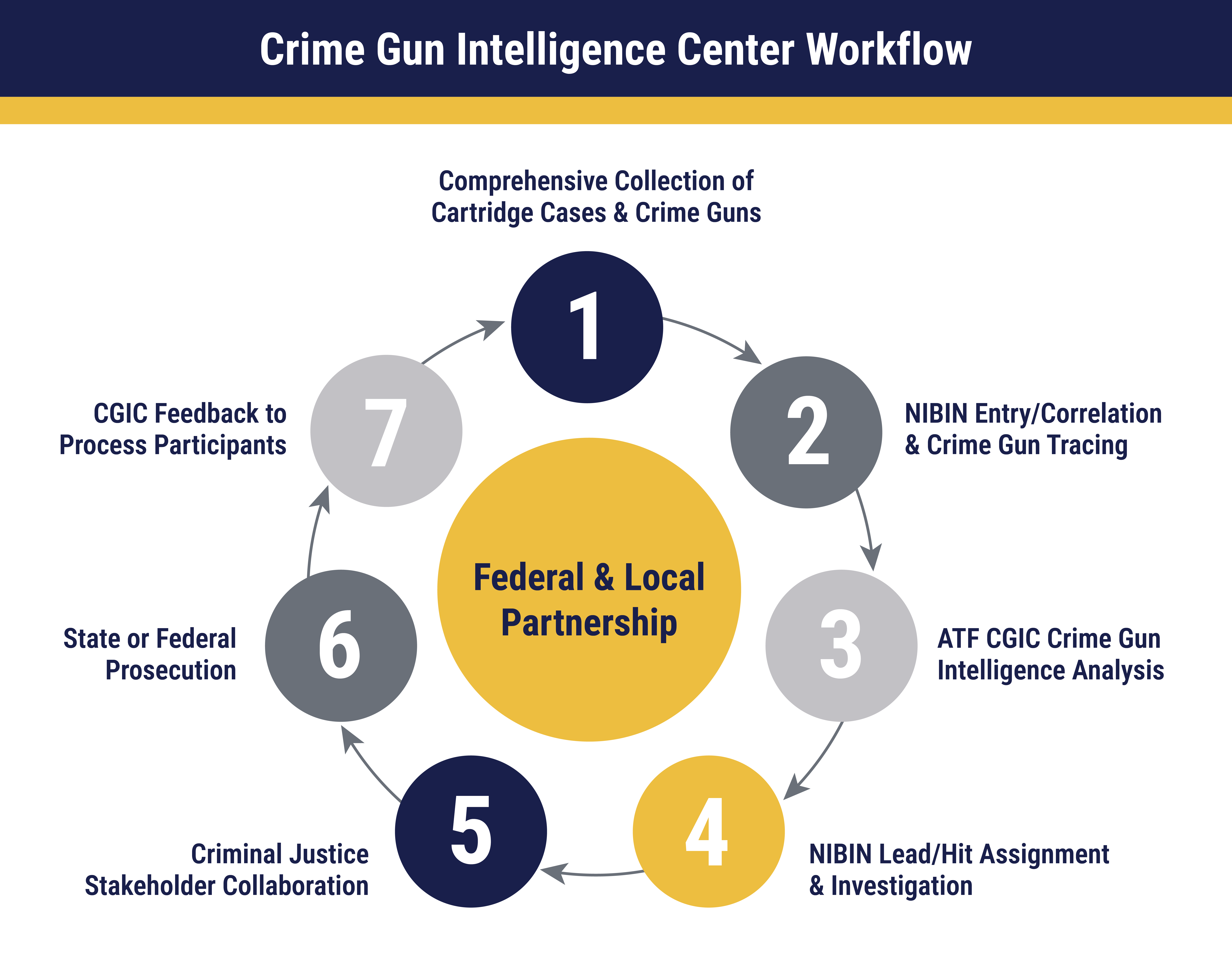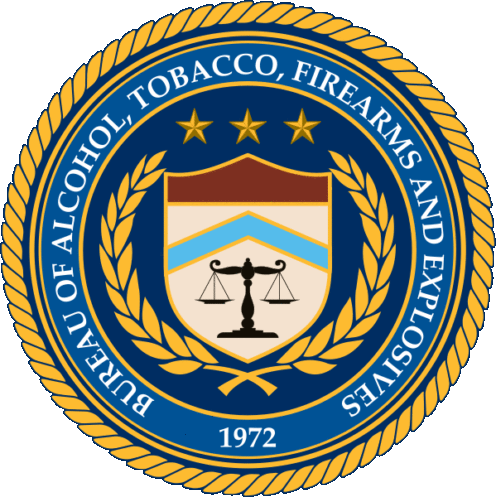As described by the Bureau of Justice Assistance (BJA), CGICs are considered an interagency collaboration focused on the immediate collection, management, and analysis of crime gun evidence, such as shell casings, in real time, in an effort to identify shooters, disrupt criminal activity, and prevent future violence. The primary outcome of these centers is identifying armed violent offenders for investigation and prosecution. Other outcomes include: the identification of crime gun sources, efficient resource allocation, providing decisionmakers with the most accurate crime data available, and increasing case closure rates, public safety, and gun crime prevention.
This program is based on the ATF Governing Board’s CGIC best practices coupled with proactive law enforcement practices that provide timely NIBIN information that promotes relevant real-time investigative leads in an effort to identify individuals considered the shooters requiring state and/or federal prosecution. Coupled with effective evidenced-based interventions such as Focused Deterrence and Hotspot Policing, these initiatives aim to decrease the incidences of gun crime; improve gun crime investigation, clearance rates, and prosecutorial outcomes; and increase public trust and confidence in law enforcement through effective community engagement.
CGICs require an intensive, ongoing collaboration between the ATF, local police department, the local crime laboratory, probation and parole, local police gang units, prosecuting attorneys, U.S. Attorney’s Office, crime analysts, community groups, and academic organizations.
Denver's Crime Gun Intelligence Center Taskforce
A unique law enforcement collaboration in Denver targeting gun crimes by using real-time forensic ballistic information to tie crimes together to help reduce violent crime.
CGIC Work Flow (7-Step Process)

For purposes of this program, the following are defined:
- Crime Gun – any firearm possessed or used, or intended to be used, during or in relation to a crime.
- eTrace –Electronic Tracing System. Internet-based system that allows participating law enforcement agencies to submit firearm traces to the ATF National Tracing Center (NTC).
- NIBIN – National Integrated Ballistic Information Network. ATF’s NIBIN is the only interstate ballistic identification system that allows law enforcement partners to associate ammunition casings, crime guns, and crime scenes.
- NIBIN Lead – a linkage of two or more gun crimes (shooting, crime gun recovery) through the utilization of NIBIN technology.
- Nibin Hit –a confirmed linkage of two or more gun crimes (shooting, crime gun recovery) through the utilization of NIBIN technology made by two certified firearms examiners.
- CGI Targeting – this is the definitive outcome of CGIC, which enables the identification of violent offenders, gun crime trends, gun crime density areas, at risk Federal Firearm Licensees (FFLs) or gun dealers, and crime gun sources. The process enables precise investigative and enforcement strategies and enhances prosecution efforts.
Essential Elements of a CGIC
Although CGIC operations may vary depending on jurisdiction, the following– as taken from a Police Chief Magazine article on the Denver Gun Crime Intelligence Center – are considered essential elements of a CGIC.
1. Utilization of Effective Gun Investigation Teams and Contractor Support
CGICs are operated by two separate but equally important teams. The Executive team is comprised of senior managers from each of the partnering agencies. Members of the Executive team meet quarterly to set strategic priorities and operational policies to review performance. This team is also responsible for ensuring quality control.
The Tactical team is responsible for daily operations. Activities of the Tactical team include but are not limited to:
- The immediate collection, analysis, and dissemination of gun crime evidence and intelligence by the ATF and local police;
- Investigation of the criminal use of firearms;
- NIBIN data analysis and lead dissemination;
- Gun Crime tracing and the identification of crime gun sources by ATF;
- Firearms trafficking interdiction by ATF and partners;
- Identification and arrest of armed criminals by the enforcement agencies; and
- Prosecution of offenders at the federal, state and local levels.
The ATF Industry Operations Investigators assist with NIBIN test-fire and NIBIN entry, comprehensive crime gun tracing, and analysis of the results. Based upon the applicant city, the NIBIN Contractor may have to be funded via the grant. The NIBIN Contractor facilitates NIBIN entries, assists in crime gun tracing, reviews crime reports related to NIBIN hits, and generates matrices to determine whether additional investigation is needed.
The CGIC also partners with local parole and probation to leverage their investigative capabilities including reviewing GPS monitoring data in the proximity of gun crimes and utilizing parole and probation as a mechanism for identifying both probationers and parolees that are shooters and the firearms used in these crimes.
2. Comprehensive Gun Crime and Forensics Tracing
Applicant city must respond to all crimes involving a firearm within the proposed CGIC specific area. The police department recovers any ballistics, which are entered into NIBIN within 24 hours. All crime gun recoveries are documented and trace requests are submitted to the ATF National Firearms Tracing Center (through eTrace) within 48 hours of recovery. NIBIN hits are triaged by crime laboratory staff and, if feasible or if the shooting involves a victim, immediately assigned to a taskforce detective and ATF special agent for investigation. These investigators provide information to detectives assigned to the NIBIN-linked cases and offer additional assistance.
3. Comprehensive Collection and Management of Crime Gun Intelligence
All crime gun data generated by NIBIN and eTrace is uniformly collected, examined, and investigated by CGIC partners to ensure that all information is shared with all CGIC stakeholders.
4. Crime Gun Intelligence Analysis
The CGIC will analyze all crime gun data collected from eTrace and NIBIN, or other forensic analysis, and ensure it is assessed, leveraged, and lawfully disseminated, to ensure appropriate linkage of crimes, guns, and, suspects. Examples of such dissemination include Crime Gun Intelligence Center Bulletins that provide valuable information to law enforcement officers.
5. Investigative Follow-Up
All actionable gun crime intelligence generated by the CGIC is disseminated to all partners and pursued using all available resources in conjunction with state and federal prosecutors.
6. Prevention and Community Engagement
All partners utilize effective community engagement practices and evidence-based programming such as focused deterrence and procedural justice to improve public trust and confidence in the justice system and to prevent community members from participating in gun crimes.
7. Performance Management
The CGIC uses data to measure outcomes including the decrease in the number of shootings, more effective deployment of resources, and increase in successful gun crime prosecution.
8. Training and Policy Development
CGIC staff and partners are continually trained on effective gun crime investigation and prosecution strategies. In addition, the CGIC develops policies that govern both police department response to gun crimes, but also the crime laboratory.
Implementing a CGIC requires implementation of comprehensive gun crime reduction strategies that includes all of the elements listed above. However, as the concept is implemented and tested in various locations, the concept will be adapted as necessary to have the desired impacts.



